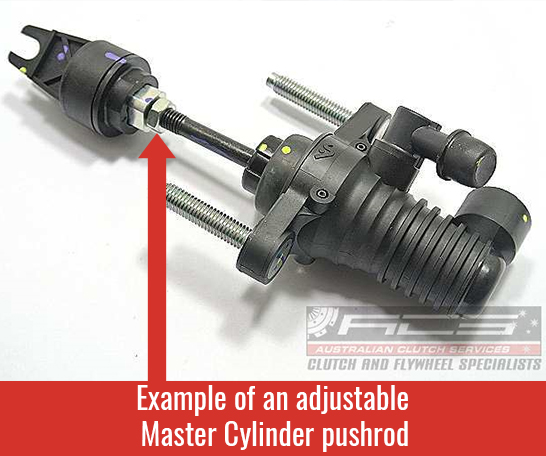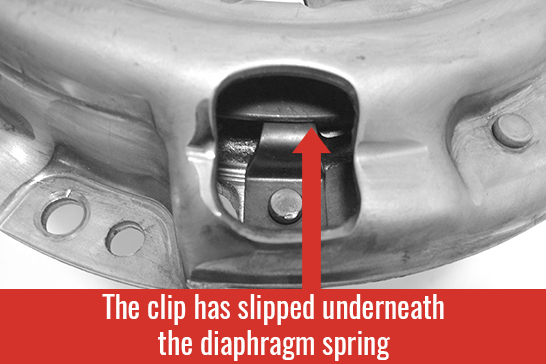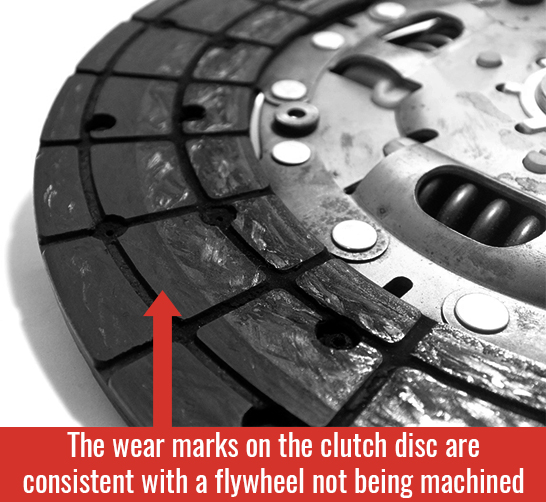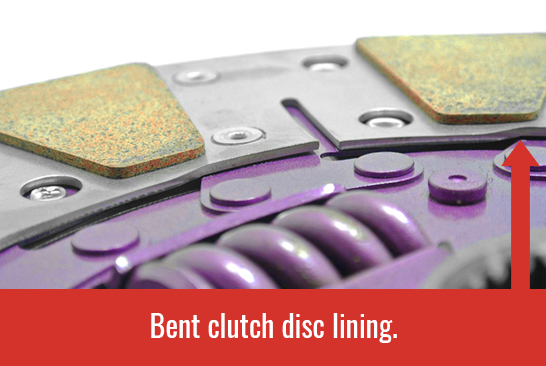Trouble Shooting »
Lining Failure
Indicator
No drive. With the clutch engaged the vehicle increases in RPM but does not move. May even have difficulties disengaging the clutch.
Causes
1. Incorrect clutch free travel
2. Worn or damaged clutch control components (Fork, Pivot Ball, Cable, Master Cylinder and/or Slave Cylinder)
3. Oil/Grease contamination
4. Driver error
Effect
The clutch has exceeded normal operating temperature resulting in the lining material to carbonize. When clutch disc linings carbonize the bonding resin in the lining material melts causing the material to break down.
Action
1. Replace clutch kit.
2. Adjust the clutch control to manufacturers specifications.
3. Inspect all clutch control components (repair or replace)
4. Inspect all oil seals for leaking. Replace if necessary.
5. Driver education.

Total Failure
Indicator
Severe bearing noise when foot is on the clutch. May even result in the pedal sticking down
Cause
1. Incorrect clutch free travel (bearing has excessive pre-load on the clutch diaphragm spring)
2. Clutch control failure (Cable, Hydraulic, Fork, Pivot Ball or Bearing Guide)
3. Driver error (The driver resting their foot on the clutch pedal whilst driving)
Effect
Incorrect release bearing clearance causes loss of grease due to significant heat. This results in total failure of the bearing
Action
1. Replace or repair any worn clutch control components
2. Replace clutch kit
3. Adjust the clutch cable or master cylinder to the manufacturer’s specifications
4. Driver education (Don’t rest the foot on the clutch pedal)

Insufficient Lubrication of the Spline
Indicator
Difficult to dis-engage gears
Cause
1. Insufficient lubrication of the clutch disc spline
2. Dirty/Contaminated splines on the gearbox
Effect
Dry splines on the clutch disc and red dust may be present
Action
1. Clean the input shaft splines removing any old grease or old clutch dust
2. Lubricate the splines (refer the fitting video https://www.youtube.com/watch?v=OrH7gCmjF-o)

CSC Contamination
Indicator
Concentric Slave Cylinder (CSC) leaking/no pedal
Cause
1. The CSC has been exposed to fluid contamination with either engine or transmission oil compromising the seal.
2. Incorrect fluid used in the hydraulic system
Effect
The internal rubber seal swells due to the contamination and in some cases splits
Action
1. Identify why the CSC has oil contamination and repair the leak (engine: rear mail seal, rocket cover gaskets – transmission: front shaft seal)
2. Thoroughly clean the back of the engine and transmission bellhousing to remove any oil residue
3. Replace the CSC
4. Flush the clutch hydraulic fluid system using the manufacturers recommended fluid.


Slipping
Indicator
Whilst in 4th gear the engine is revving but the speed of the vehicle is not increasing
Cause
- There is incorrect clutch free travel
- The clutch control mechanisms are faulty (fork, pivot ball, cable, and/or clutch hydraulics
- Worn out clutch kit
Effect
The clutch diaphragm has been partially disengaged causing the disc to spin within the housing or the disc thickness as reduced enough for it to slip.
Action
- Correct the clutch free travel as per manufacturers specifications
- Replace any worn or damaged components
- Renew the clutch kit

Clutch Slipping
Indicator:
Clutch Slipping
Cause:
1. The clutch hydraulics may have a failure
2. Incorrect clutch free travel setting
3. Vehicle is constantly overloaded
4. Incorrect clutch for the application
5. Poor driving practices (the driver resting their foot on the clutch pedal when driving)
6. The clutch is worn beyond its service life
Effect:
The vehicle is unable to drive correctly and has a burning smell coming from the gearbox area.
Action:
1. Assess the vehicle loads and conditions the vehicle is being used for.
2. Driver training and education if necessary
3. Check the vehicle hydraulics. This can be done by either undoing the bled nipple on the slave cylinder or pushing the slave cylinder pushrod back by hand. If there is residual line pressure the fluid will “shoot” out when cracking the bleeder. If trying to push the pushrod back again holding line pressure will prevent the pushrod from moving in the slave bore. In both cases it would identify a master cylinder problem or a clutch pedal over adjustment.
4. Check the clutch free travel settings. The clutch pedal should have some “free” movement at the top of the pedal.
5. If the clutch is worn beyond its service life it will need replacing.
Clutch Shudder
Indicator:
Clutch Shudder
Effect:
The vehicle has a severe shudder on take-off or/and between gear changes
Cause:
1. If a new clutch has been fitted the flywheel must have been machined-If it has not, then this may cause the shudder (please note: flywheels which are not machined may affect the clutch warranty)
2. Incorrect flywheel machining (i.e machined on a lathe)
3. The clutch disc may have oil/grease contamination
4. Engine and/or gearbox mounts are worn or damaged
5. Incorrect bedding in procedure
Action:
1. Check engine and gearbox mounts-repair or replace as necessary
2. Check for any engine or gearbox oil leaks that can impact on the clutch (rear main seal, rocker cover or front gearbox seal)-repair as necessary
3. All new clutch components must be in service for a minimum of 1,000 kilometres of normal driving for efficient bedding in.


Complete Loss of Drive
Indicator:
Complete Loss of drive
Cause:
1. The clutch centre has had a total failure
2. The linings have come off the clutch disc
Effect:
The clutch is unable to transfer the engine power through the driveline.
Action:
1. Remove gearbox
2. Identify the reasons for the failure (see Trouble Shooting Clutch Disc Loss of Drive)
3. Replace clutch kit and renew (machine flywheel) or replace any other clutch service components (spigot/dual mass)

Vibration/Noise on start-up and with acceleration and de-acceleration
Indicator:
Vibration/Noise on start-up and with acceleration and de-acceleration
Cause:
The worn dual mass flywheel is causing vibration/noise
Effect:
1. There is a harsh noise and/or vibration when the vehicle is started or when shut down
2. There is a harsh noise and/or vibration when the vehicle is revved or under de-acceleration
Action:
1. Assess the vehicle loads and conditions the vehicle is being used for.
Difficulties with clean gear selection
Indicator:
Difficulties with clean gear selection (including when a new clutch has been fitted).
Cause:
1. The release of the clutch is insufficient (this will give a low clutch engagement)
2. The clutch hydraulics are preventing the clutch to operate efficiently
3. The clutch control system is not operating correctly allowing correct release (fork, pivot ball, operating cable etc)
Effect:
The clutch disc is not released correctly and still driving the gearbox
Action:
1. Assess the master cylinder adjustment (most have an adjustable push rod to lengthen the operating stroke)
2. Bleed the system to remove any trapped air (bleeding tools may be required to bleed correctly)
3. Assess the operating mechanisms to ensure they are serviceable an allowing the clutch to have optimum travel.

Noise or squeak coming from the bellhousing area
Indicator:
Noise or squeak coming from the bellhousing area
Cause:
Poorly lubricated Clutch Fork, Pivot Ball, Bearing to Fork contact face or Bearing guide tube (Incorrect release bearing failure diagnosis)
Effect:
1. These noises will be identified when the clutch is engaged (foot off the pedal).
2. To check with the vehicle running and foot off the clutch, if the noise is present apply the clutch – if the noise disappears then the likelihood of the bearing being at faulty is low. Please see below for remedy.
3. To double check the problem lubricate the clutch fork/pivot ball and back of the bearing with some spray lubrication. If the noise has disappeared then the likelihood of a bearing failure is eliminated. Please note spray lubrication is only a short term solution and the noise will come back with use. Please also be careful not to over lubricate the release components as it may compromise the clutch operation
Action:
1. Remove the gearbox. Inspect all clutch control components – Repair or replace if necessary
2. Clean and lubricate all moving components in the clutch operation system. ACS recommends SPG3 lubricating grease which is available from your local distributor.

Cracked CSC Bearing Guide/Base
Indicator:
Concentric Slave Cylinder (CSC) leaking/No pedal
Cause:
1. Incorrect mounting procedure (over torqued bolts or bolts missing)
2. CSC Misalignment (CSC off centre axis)
3. Spigot bearing/Bush damaged or missing
Effect:
Cracked CSC bearing guide/base
Action:
1. Replace CSC
2. Ensure mounting surface is clean and free of any debris
3. Replace any worn or missing bolts
4. Torque the mounting bolts to the manufacturers specifications
5. Replace spigot bearing/bush if necessary

Commercial Clutch Brake Not Working
Indicator:
No dis-engagement
Cause:
Clutch brake not operating (Pull-Type Commercial Clutch)
Effect:
1. Worn cross shafts
2. Worn cross shaft bushes in bellhousing
3. Worn or damaged clutch fork
4. Excessive wear on release bearing housing
Action:
1. Replace clutch kit
2. Replace cross shafts
3. Replace cross shaft bushes
Worn Release Bearing Thrust Face
Indicator:
Noise and rough pedal action
Cause:
1. Excessive misalignment of the release bearing
2. Excessive pre-load of the release bearing
Effect:
Worn release bearing contact face
Action:
1. Replace release bearing/Clutch kit
2. Check all clutch control components for service – if worn replace (bearing carrier, clutch for, gearbox nose cone, CSC mounting surface)
3. Incorrect clutch control setting – Incorrect (mechanical) or clutch master cylinder setting
Poor Lubrication of Release Bearing
Indicator:
Noise or squeak when the clutch is engaged (foot off the clutch)
Cause:
1. Poor lubrication of the release bearing and clutch fork contact points
2. Poor lubrication of the pivot ball/cross shaft
3. Worn/Damaged clutch fork
4. Worn/Damaged pivot ball/cross shaft
Effect:
The bearing has fatigue due to the metal on metal operations
Action:
1. Check the bearings operation for noise – if necessary replace
2. Lubricate all contact points (fork to bearing contact points, pivot ball, cross shaft)
3. Inspect all clutch control components and if necessary replace or repair.
Incorrect Bearing Fitment
Indicator:
Noise upon engaging and disengaging the clutch
Cause:
1. The bearing has been fitted to the carrier incorrectly (wrong way around)
Effect:
Total failure of the release bearing/clutch finger wear
Action:
1. Replace the bearing/clutch kit
2. Ensure the bearing is fitted to the carrier correctly
Clutch Thrust Bearing Bent
Indicator:
Release Bearing Noise & Pedal Vibration
Cause:
1. Incorrectly fitted press on release bearing to the carrier
Effect:
Bent Release bearing
Action:
1. Replace release bearing
2. Use a fitting tool to fit the bearing to the carrier
CSC Body Cracked
Indicator:
Poor performance of the Concentric Slave Cylinder (CSC)
Cause:
1. Incorrect mounting procedure (Incorrect torque)
2. Mounting surfaces not clean and free of debris
3. Poor handling techniques (dropped)
Effect:
CSC body is cracked
Action:
1. Replace CSC
2. Ensure the mounting surfaces are clean and free from any contaminants/debris
3. Always handle the CSC with care
Bearing Mis-alignment
Indicator:
Noise upon application
Cause:
1. Assembled incorrectly
Effect:
The bearing is not aligned on the Concentric Slave Cylinder (CSC)
Action:
1. Replace CSC
CSC Rear Seal Dislodged
Indicator:
Concentric Slave Cylinder (CSC) leaking
Cause:
1. Incorrect handling procedure
2. Incorrect fitment to the transmission
Effect:
The CSC rear seal has become dislodged
Action:
1. Locate the CSC correctly
2. Ensure all mounting surfaces are clean and free of debris
3. Torque the bolts to manufacturers specifications
CSC Exceeds Maximum Stroke
Indicator:
Concentric Slave Cylinder (CSC) leaking
Cause:
The CSC has exceeded maximum stroke
Effect:
1. Master cylinder failure
2. Incorrect clutch free travel
3. Incorrect bleeding practices
Action:
1. Replace CSC
2. Inspect Clutch Master Cylinder – replace if necessary
3. Adjust clutch free travel to manufacturers specifications
4. Follow the ClutchTech bleeding procedure (In some cases the CSC will need to be bleed with a reverse type vacuum bleeder)
Cracked CSC
Indicator:
Concentric Slave Cylinder (CSC) leaking/No pedal
Cause:
1. Incorrect mounting procedure (over torqued bolts or bolts missing)
2. Poor bleeding procedure
3. Pipe/Feed line obstructions leading into the CSC
Effect:
Cracked CSC body
Action:
1. Replace CSC
2. Replace any worn or missing bolts
3. Torque the mounting bolts to the manufacturers specifications
4. Ensure the inlet line is free from obstructions.
5. Always follow ClutchTech bleed procedure (in some cases a reverse vacuum bleed may be required)
Thrust Bearing Broken Lug
Indicator:
The clutch is noisy and the pedal can be slack.
Cause:
• A lug has broken
• Another fault in the mechanical operation of the clutch has caused the lug to break.
• For example, the fork is out of shape or badly positioned at the time of assembly.
Effect
A locating lug on the release bearing has broken.
Action
Check the fork and the guide sleeve and replace if signs of wear present. Ensure components are lubricated. Carefully check the clutch cable.

Premature Dual Mass Flywheel Failure
Indicator:
Dual Mass Flywheel Vibration/Knocking/Noise and beyond tolerance
Cause:
1. Multiple fault codes
2. Power/Battery Unit Failure
3. Fuel error i.e Injector or injector pump failure
4. Drivetrain has been submerged in water
5. Power increase to vehicle
Effect:
Vibration/Knocking noise on start-up/shut down and/or acceleration or de-acceleration.
Action:
1. Clear all fault codes
2. Check power unit
3. Check fuel system
4. Reseal gearbox to watertight (boots, inspection plates and any other openings)
5. Replace Dual Mass Flywheel
Thermal Loading
Indicator:
Clutch Slipping
Cause:
1. Overloading the clutch causing excessive thermal loading
2. Overloading the vehicle causing excessive heat transfer
3. Driver error
Effect:
Premature clutch wear/poor clutch performance
Action:
1. Replace/machine flywheel (Dual Mass Flywheels cannot be machined)
2. Driver education
Dual Mass Flywheel Slipping
Indicator:
Clutch Slip/No drive
Cause:
1. Dual Mass Flywheel exceeds manufacturer’s specifications
2. Dual Mass arc springs have failed
Effect:
The Dual Mass secondary surface (disc operating surface) spins on the primary (mounting) surface.
Action:
1. Replace Dual Mass Flywheel
Excessive Runout on Flywheel
Indicator:
Clutch Slipping
Cause:
1. Poor machining practices
2. Not machining or replacing the flywheel when fitting a new clutch
3. The flywheel has been exposed to excessive thermal overload
Effect:
Worn flywheel/Running face not true and flat
Action:
1. Replace clutch kit and machine/replace flywheel
2. After machining check to make sure the step (if required) is correct and the surface is flat.
Glazed Pressure Plate Surface
Indicator:
Shudder/Judder
Cause:
1. Excessive heat generated within the clutch components - Overloading the clutch
2. Carrying excessive loads - Overloading the vehicle
3. Incorrect clutch free travel
4. Incorrect driving practices (Riding the clutch)
5. Poor flywheel grinding surface finish
Effect:
Pressure plate surface and/or the flywheel surface are excessively glazed and has a mirror type finish.
Action:
1. Replace clutch kit
2. Check clutch control mechanisms and if necessary repair or replace.
3. Correct clutch free travel settings
3. Driver education
De-Adjusted SAC
Indicator:
Poor pedal feel/Clutch Slipping
Cause:
1. The clutch kit is worn beyond its service life
2. Incorrect installation
3. Incorrect clutch free travel settings
4. Faulty clutch hydraulics
5. Incorrect flywheel step
Effect:
Clutch self-adjusting mechanism has moved to its fully worn out position.
Action:
1. Replace Clutch Kit
2. Check clutch hydraulics and repair or replace if necessary
3. Set correct clutch free travel
4. Verify correct flywheel step
5. Use self-adjusting fitting tool for the fitting process
A guide for installing a self-adjusting clutch cover can be found here.
Worn Diaphragm
Indicator:
Slipping/Poor clutch engagement or dis-engagement/Metallic Noise at the bottom of the pedal
Cause:
Insufficient clearance between the release bearing and the clutch operation spring
Effect:
1. Clutch diaphragm spring has excessive wear
2. Clutch diaphragm spring has broken
3. Release bearing shows signs of fatigue (notchy or seized)
Action:
1. Replace clutch kit
2. Inspect the clutch operating system and repair or replace if necessary (Pivot Ball, Release Fork, Cross Shafts, Master Cylinder, Slave Cylinder, Clutch Cable and Pedal Box).
3. Set correct clutch free travel
Worn Facing Fibres
Indicator:
Slipping clutch/Incorrect clutch operation
Cause:
1. Bell housing has not been degreased and cleaned. Poor installation of the new clutch. The new clutch disc has not worn but fibres have become lodged in the new clutch cover are that of the previously worn clutch. It is a requirement due to ventilation designs that the bell housing area free from old fibres, dirt and grease when installing new clutch.
2. This problem is common in 4 wheel drive vehicles when an inspection cover or a clutch fork cover boot has not been Inspected for re-use or replaced when installing a new clutch.
Effect:
Worn clutch disc facing fibres and/or dirt lodged between diaphragm spring and clutch cover housing causing loss of cover clamping force.
Action:
1. Ensure the bell housing and back of the engine are thoroughly degreased and cleaned of foreign material before installing a new clutch.
2. Ensure inspection locations are sealed correctly with any boots thoroughly inspected for re-use and if necessary replaced. (Note: These problems are common on farm vehicles, vehicles travelling on sand and 4x4 recreational vehicles.)
Hold Down Bolts
Indicator:
Clutch Slipping/Noisy in operation
Cause:
Pressure plate assembly hold down bolts have not been removed after the pressure plate has been mounted and torqued to the flywheel.
Effect:
1. Hold down/Shipping bolts not removed and slipping when a new clutch has been installed
2. Unable to get correct clutch free travel adjustment
3 Unable to get correct clutch operation
Action:
Remove hold down bolts (Do not remove or adjust the clutch lever adjustment nuts/bolts)
Contamination of Friction Surfaces
Indicator:
Slipping clutch/Judder.
Cause:
1. Excessive grease used upon installation (Bearing Slide and/or shaft splines)
2. Incorrect lubricant
3. Rear main seal leak
4. Front gearbox seal leak
5. Poor practice of cleaning the clutch components prior to installation.
Effect:
Oil/Grease or other contaminants on the friction surfaces.
Action:
1. Replace Clutch kit
2. Lightly grease spline, wipe off excessive grease after tentative installation and ensure there is smooth sliding of clutch disc on main drive shaft.
3. Remove any excessive grease from the bearing slide after tentative installation.
4. Clean pressure plate surface and flywheel surface with a non-oil based solvent (Mentholated Spirits, Thinners or Brake Clean)
5. Inspect all engine and gearbox seals and if necessary replace.
Grease on Friction Surfaces
Indicator:
Slipping clutch/Judder.
Cause:
1. Excessive grease used upon installation (Bearing Slide and/or shaft splines)
2. Incorrect lubricant
3. Rear main seal leak
4. Front gearbox seal leak
5. Poor practice of cleaning the clutch components prior to installation.
Effect:
Oil/Grease or other contaminants on the friction surfaces.
Action:
1. Replace Clutch kit
2. Lightly grease spline, wipe off excessive grease after tentative installation and ensure there is smooth sliding of clutch disc on main drive shaft.
3. Remove any excessive grease from the bearing slide after tentative installation.
4. Clean pressure plate surface and flywheel surface with a non-oil based solvent (Mentholated Spirits, Thinners or Brake Clean)
5. Inspect all engine and gearbox seals and if necessary replace.
Pressure Plate Oil Contamination
Indicator:
Shudder
Cause:
1. Poor cleaning practices when fitting
2. Excessive grease used on the bearing slide and/or splines
3. Rear engine seal failure
4. Front gearbox seal failure
Effect
Oil or grease contamination on the cover and operating surfaces.
Action:
1. Replace clutch kit
2. Clean all components prior to fitment removing all lubricants and protective coatings.
3. Remove any excessive grease from the spline and/or thrust bearing after installation.
4. Replace rear engine seal if necessary
5. Replace front gearbox seal if necessary

Glazed Pressure Plate Surface
Indicator:
Shudder/Judder
Cause:
1. Excessive heat generated within the clutch components - Overloading the clutch
2. Carrying excessive loads - Overloading the vehicle
3. Incorrect clutch free travel
4. Incorrect driving practices (Riding the clutch)
5. Poor flywheel grinding surface finish
Effect:
Pressure plate surface and/or the flywheel surface are excessively glazed and has a mirror type finish.
Action:
1. Replace clutch kit
2. Check clutch control mechanisms and if necessary repair or replace.
3. Correct clutch free travel settings
3. Driver education
Worn Diaphragm
Indicator:
Pedal graunch-erratic feeling when depressing clutch pedal with engine running but ok when not running/notchy clutch pedal.
Cause:
Excessively worn diaphragm fingers
Effect:
1. Eccentricity between the axis of rotation of the clutch cover pressure plate and assembly and that of the clutch thrust bearing.
2. Worn release bearing sleeve carrier, clutch fork or pivot ball/cross shaft
3. Incorrect clutch free travel
4. Clutch control mechanism failure (Hydraulic/Cable or Linkage)
Solution:
1 Check engine to gearbox dowels and replace if necessary
2 Check the gearbox nose cone for wear and repair or replace if necessary
3 Check clutch fork and pivot ball/cross shaft and repair or replace if necessary
4 Adjust free travel to manufacture’s specification
5 If available use self-aligning bearing
Bearing Retainer Clip
Indicator:
No pressure at clutch pedal (after installation of a Pull-Type clutch)
Cause:
1. Incorrect fitting procedure
2. Damaged bearing retainer clip upon installation
3. Incorrect clutch for orientation
4. Poor handling procedure
Effect:
Bearing not located in pressure plate
Action:
1. Replace bearing clip/Cover
2. Show care when fitting the clutch and installation of the gearbox
3. Ensure the clutch fork is fitted in the correct direction
4. Show care when handling the covers ensuring never to pick the clutch up by its centre
Burst Pressure Plate
Indicator:
Loss of drive
Cause:
Clutch casting has had a total failure
Effect:
1. Excessive thermal overload
2. Incorrect driving practices
3. Clutch control failure
4. Driver error
Action:
1. Replace clutch kit
2. Check clutch control mechanisms and repair or replace if necessary
3. Driver education
Bent Straps
Indicator:
Unable to dis-engage the clutch
Cause:
1. Improper driving practice.
2. Sudden down changing of gears i.e. 5th gear to 2nd gear.
3. Constant “dropping” of clutch at extremely high RPM when taking off.
4. Poor handling/shipping practises
Effect:
Bent drive/lifting straps
Action:
1. Renew clutch kit
2. Driver education
Warped Clutch Cover
Indicator:
Slipping/Poor clutch performance
Cause:
1. Excessive heat caused the pressure plate surface fatigue.
2. Only replaced the clutch disc and pressure plate was not assessed.
Effect:
Warped clutch cover pressure plate assembly
Action:
1. Replace the clutch kit

Retractor Clip Dislodged/Stretched
Indicator:
No gear selection/difficult engagement
Cause:
Retractor clip has become dislodged/stretched
Action:
1. Over adjustment of clutch has caused the stretching of the retractor clip
2. The pressure plate has been dropped
3. The pressure plate has been damaged in transit
Action:
1. Replace clutch cover
2. Inspect the clutch operating adjustments
3. Always practice safe handling of the cover when fitting
4. Inspect the clutch cover prior to fitment to ensure there are no retractor clip issues.

Worn Clutch Disc Facing and/or Dirt Lodged Between Diaphragm Spring & Clutch Cover
Indicator:
Slipping clutch/Engagement and Dis-Engagement Problems
Cause:
- Bell housing has not been degreased and cleaned. Poor installation of the new clutch. The new clutch disc has not worn but fibres have become lodged in the new clutch cover are that of the previously worn clutch. It is a requirement due to ventilation designs that the bell housing area free from old fibres, dirt and grease when installing new clutch.
- This problem is common in 4 wheel drive vehicles when an inspection cover or a clutch fork cover boot has not been Inspected for re-use or replaced when installing a new clutch.
Effect:
Worn clutch disc facing fibres and/or dirt lodged between diaphragm spring and clutch cover housing causing loss of cover clamping force.
Action:
- Ensure the bell housing and back of the engine are thoroughly degreased and cleaned of foreign material before installing a new clutch.
- Ensure inspection locations are sealed correctly with any boots thoroughly inspected for re-use and if necessary replaced. (Note: These problems are common on farm vehicles, vehicles travelling on sand and 4x4 recreational vehicles.)

Difficulties engaging gears. Noise when clutch is engaged
Cause:
1. Severe misalignment.
2. Poor bush lubrication (insufficient oil in the bush
Effect:
Damaged spigot bush/bearing
Action:
1. Replace spigot bush
2. Check engine to gearbox dowels - replace if necessary
3. "Sweat" bronze bushes in oil if necessary.

Slave Cylinder Seal Failure
Indicator:
Clutch slave cylinder leaking
Cause:
1. The slave cylinder has exceeded maximum stroke causing the seal to be exposed past its operating bore
2. Contaminated fluid – Moisture (causes rust), Fine particles (causes seal fatigue)
Effect:
Damage to the main seals of the slave cylinder
Action:
1. Replace slave cylinder/main seals
2. Check the master cylinder operation to ensure it is not over stroking the slave cylinder
3. Flush the clutch hydraulic system

Inconsistent Pedal Feel/ Clutch Master Cylinder Failure
Indicator:
Inconsistent pedal feel/Clutch Master Cylinder failure
Cause:
Contaminated or old clutch fluid
Effect:
1. Master cylinder leaking
2. Damage to the main internal seals (causing a bypass)
3. Moisture in the clutch fluid
Action:
1. Replace clutch master cylinder – if necessary
2. Replace the hydraulic fluid (only use manufactures specified fluid)
3. Flush the clutch hydraulic system completely to remove any residual contamination.

Worn Disc Linings
Indicator:
Clutch slipping
Cause:
1. Clutch control failure
2. Linings have been exposed to excessive heat.
Effect:
Clutch disc linings worn out
Action:
1. Replace clutch disc/kit
2. Check clutch operating mechanisms
3. Set clutch free travel to manufacturers specifications

Broken Facings
Indicator:
Slipping/Shudder/Judder - Poor clutch performance
Cause:
1. Overloading the clutch
2. Overloading the vehicle
3. Clutch disc has been over torqued (Changing from 5th to 2nd at high speed)
Effect:
Broken clutch lining
Action:
1. Replace clutch disc/kit
2. Driver education

Difficulties disengaging gear/Slipping
Cause:
1. CSC operating off axis (mis-aligned)
2. Incorrect mounting of the CSC (Incorrect torque or bolts missing)
Effect:
Concentric Slave Cylinder (CSC) internal piston not travelling smoothly causing a system failure
Action:
1. Replace CSC
2. Make sure the CSC mounting surfaces are free from debris, grime and any sealants (please note sealants should not be used unless the manufacturer has specified to do so - this will cause the CSC to mount off axis)
3. Check and Inspect mounting bolts - if necessary replace
4. Torque to manufacturers specifications.
-malfunction01.jpg)
-malfunction02.jpg)
Burst Facings
Indicator:
Loss of drive/no transmitted power
Cause:
1. The clutch disc has had a torque overload (i.e 5th to 2nd at high speed)
2. Clutch control failure (Clutch hydraulics/Clutch cable)
3. Incorrect clutch free travel
4. Overloading the clutch
5. Overloading the vehicle
Effect:
The clutch disc linings have had a total failure
Action:
1. Replace the clutch disc/kit (ensure all fibrous material is removed from the gearbox and back of engine)
2. Check and inspect all clutch control mechanisms - repair or replace if necessary
3. Set clutch free travel to manufacturer’s specifications.
4. Driver education

Burnt Facings
Indicator:
Slipping/Lost Drive
Cause:
1. Oil or grease contamination on the clutch disc
2. Faulty clutch release system
3. Incorrect clutch free travel
4. Overloading the clutch
5. Overloading the vehicle.
Effect:
Linings have deteriarated or missing due to excessive clutch slip
Action:
1. Replace the clutch kit and machine the flywheel
2. Check and assess all oil seals – replace if necessary
3. Thouroughly inspect all release mechanism components (fork, pivot ball, pedal box, cross shafts, clutch hdraulics/release cables)
4. Set clutch free travel to manufacturer’s specifications.
5. Driver eductaion

Disc Contamination
Initiator:
Slipping Clutch/Shudder or Judder
Cause:
1. Rear main engine seal failure/fatigue
2. Front gearbox seal failure/fatigue
3. Excessive lubrication on the clutch disc splines/gearbox nose cone/release bearing
Effect:
Oil or Grease contamination on the clutch disc linings
Action:
1. Replace the clutch disc/kit
2. Inspect the rear main seal for leaking – replace if necessary
3. Inspect front gearbox seal – replace if necessary
4. Inspect any other engine oil leaks which could compromise the gearbox bellhousing (i.e sump gasket, rocker cover etc)
5. Remove any excessive lubrication from the clutch components once they have been checked for compatibility.


Over Lubrication of Friction Disc
Indicator:
Clutch Slipping/Shudder or Judder
Cause:
1. Excessive use of grease when lubricating the components on assembly.
Effect:
Clutch disc linings are contaminated with grease/oil
Action:
1. Replace clutch disc
2. Remove any excess grease from the clutch components after they have been checked for compatibility


Flywheel has not been machined
Indicator:
Clutch Shudder/Judder
Cause:
1. Un-machined flywheel (not even/warped)
2. Poor flywheel grinding practices (machined on a lathe)
Effect:
Vehicle vibrates when the clutch is released
Action:
1. Surface grind the flywheel
2. Check the machining surfaces are true and parallel

Fused Friction Material
Indicator:
Non-release/Shudder
Cause:
1. The clutch disc has exceeded maximum temperature.
2. The flywheel was not machine when the new clutch was installed
3. Overloading the clutch disc (excessive clutch "kicks" or launching)
Effect:
Ceramic friction material has fused to the flywheel
Action:
1. Replace the clutch disc
2. Always machine the flywheel when fitting a new clutch
3. Driver education


Wrong Friction Disc
Indicator:
Noisy/No disengagement
Cause:
1. Not checking part suitability when installing the clutch
2. Incorrect disc for application (disc only replacements which do not suit the cover)
Effect:
Clutch disc does not suit the clutch cover
Action:
1. Replace kit to a matched kit
2. Education for clutch installer


Spring & Stop Pin Damage
Indicator:
Loss of dive/Poor clutch performance/Noisy in operation
Cause:
1. Engine to gearbox dowels missing or damaged
2. Gearbox and/or engine mounting face damaged or have high levels of contamination
3. Obstructions between engine and gearbox mounting face preventing the gearbox to be flush to the engine when mounted.
4. Missing/damaged or incorrectly torqued gearbox mounting bolts
5. Clutch disc overload (Changing from 5th to 2nd at high speed)
6. Excessive RPM load (Launching the vehicle at high RPM)
Effect:
Clutch disc damper springs have become dis-lodged and stop pins are damaged
Action:
1. Replace clutch kit
2. Replace gearbox dowels
3. Ensure the gearbox and engine mating surfaces are free from contamination.
4. Ensure there are no obstructions between engine and gearbox when final torqueing of the gearbox mounting bolts
5. Replace worn or damaged gearbox mounting bolts if necessary
6. Driver education
Broken Damper Springs
Indicator:
Loss of dive/Poor clutch performance
Cause:
1. Engine to gearbox dowels missing or damaged
2. Gearbox and/or engine mounting face damaged or have high levels of contamination
3. Obstructions between engine and gearbox mounting face preventing the gearbox to be flush to the engine when mounted.
4. Missing/damaged or incorrectly torqued gearbox mounting bolts
Effect:
Clutch disc failure due to mis-alignment (gearbox centre off-axis to crankshaft)
Action:
1. Replace clutch kit
2. Replace gearbox dowels
3. Ensure the gearbox and engine mating surfaces are free from contamination.
4. Ensure there are no obstructions between engine and gearbox when final torqueing of the gearbox mounting bolts
5. Replace worn or damaged gearbox mounting bolts if necessary
Broken Drive Hub/Damaged Stop Pins
Indicator:
Noise, difficulties changing gears
Cause:
Broken drive hub on clutch disc/Damaged stop pins
Effect:
1. Severe engine to gearbox mis-alignment
2. Excessive down shifting (Changing from 5th to 2nd at high speed)
3. RPM overload of the clutch disc (High RPM launching)
Action:
1. Replace clutch disc
2. Check engine to gearbox dowels are present and in a serviceable condition (Replace if necessary)
3. Driver education.

Sudden Clutch Failure
Indicator:
Sudden Clutch Failure.
Cause:
1. Faulty or worn pilot bearings or bushing
2. Hanging gear box during installation
3. Contamination between mating surfaces of the engine bolt up areas.
4. Severe engine to gearbox mis-alignment
5. Clutch disc overload (Shifting from 5th to 2nd at high speed)
6. Transmission failure
Effect:
Clutch hub failure.
Action:
1. Check pilot bearing and replace if necessary.
2. Inspect engine to gearbox dowels are serviceable and if damaged replace
3. Align clutch to the flywheel and show care when fitting the gearbox.
4. Ensure the engine and gearbox have clean mating surfaces before installation.
5. Check gear box for metal fragments then remove and repair parts in necessary.
6. Driver education

Damaged Facing Material
Indicator:
No drive
Cause:
1. Overloading the clutch disc (example: shifting from 5th to 2nd at high speed)
Effect:
Clutch disc lining broken
Action:
1. Replace clutch disc
2. Driver education
-final.jpg)
Clutch disc splines damaged
Indicator:
Loss of drive
Cause:
1. Gearbox misaligned (gearbox to engine dowels damaged or missing)
2. Input shaft damaged
Effect:
Spline worn/damaged or missing
Action:
1. Replace clutch disc
2. Inspect gearbox to engine dowels are present and serviceable (if damaged replace)
3. Inspect the Input shaft for excessive wear and damage.

Broken Segments
Indicator:
Loss of drive/Noisy when operating the clutch pedal
Cause:
1. Clutch disc has been over torqued - example: down changing from 5th to 2nd gear at high speed
2. Severe engine to gearbox mis-alignment - Red dust will be present when alignment issues are present.
3. Clutch disc has been overloaded
4. Damaged pilot bearing/bush
5. Damaged upon fitment
Effect:
The disc outer has come off the drive hub
Action:
1. Replace the clutch disc
2. Check all engine to gearbox dowels are present and in a serviceable condition (If necessary replace)
3. Replace pilot bearing/bush
4. Show care when fitting the gearbox making sure there is no possibility of damaging the drive up causing the spring fatigue (hanging the gearbox on the clutch disc)
5. Driver education
Worn Splines
Indicator:
Difficulties changing gears
Cause:
1. Gearbox misaligned (gearbox to engine dowels damaged or missing)
2. Input shaft damaged
Effect:
Spline damaged on the clutch disc from incorrect alignment
Action:
1. Replace clutch disc
2. Inspect gearbox to engine dowels are present and serviceable (if damaged replace)
3. Inspect the Input shaft for excessive wear and damage.
Race Clutch Spline Damage
Indicator:
Difficulties changing gears
Cause:
1. Gearbox misaligned (gearbox to engine dowels damaged or missing)
2. Input shaft damaged
Effect:
Spline damaged on the clutch disc from incorrect alignment
Action:
1. Replace clutch disc
2. Inspect gearbox to engine dowels are present and serviceable (if damaged replace)
3. Inspect the Input shaft for excessive wear and damage.
Severe Misalignment Between Mating Surfaces
Indicator:
Loss of dive/Poor clutch performance
Cause:
1. Engine to gearbox dowels missing or damaged
2. Gearbox and/or engine mounting face damaged or have high levels of contamination
3. Obstructions between engine and gearbox mounting face preventing the gearbox to be flush to the engine when mounted.
4. Missing/damaged or incorrectly torqued gearbox mounting bolts
Effect:
Clutch disc failure due to mis-alignment (gearbox centre off-axis to crankshaft)
Action:
1. Replace clutch kit
2. Replace gearbox dowels
3. Ensure the gearbox and engine mating surfaces are free from contamination.
4. Ensure there are no obstructions between engine and gearbox when final torqueing of the gearbox mounting bolts
5. Replace worn or damaged gearbox mounting bolts if necessary
Disc Bent
Indicator:
Clutch fails to release/poor clutch performance
Cause:
1. Hanging the transmission on the clutch disc (not locating the gearbox over the dowels)
2. Incorrect gearbox mounting (forcing the gearbox onto the engine with the bolts)
Effect:
Bent clutch disc
Action:
1. Replace clutch disc/Clutch kit
2. Always practice safe installation of the transmission
3. Align the clutch disc to the engine with the correct clutch alignment tool.
Broken drive hub outer
Indicator:
Loss of drive/Noisy when operating the clutch pedal
Cause:
1. Clutch disc has been over torqued - example: down changing from 5th to 2nd gear at high speed
2. Severe engine to gearbox mis-alignment - Red dust will be present when alignment issues are present.
3. Clutch disc has been overloaded
4. Damaged pilot bearing/bush
5. Damaged upon fitment
Effect:
The disc outer has come off the drive hub
Action:
1. Replace the clutch disc
2. Check all engine to gearbox dowels are present and in a serviceable condition (If necessary replace)
3. Replace pilot bearing/bush
4. Show care when fitting the gearbox making sure there is no possibility of damaging the drive up causing the spring fatigue (hanging the gearbox on the clutch disc)
5. Driver education
Damaged Torsion Springs
Indicator:
Unable to disengage gears/Noisy clutch operation
Cause:
1. Clutch disc has been over torqued - example: down changing from 5th to 2nd gear at high speed
2. Severe engine to gearbox mis-alignment - Red dust will be present when alignment issues are present.
3. Damaged pilot bearing/bush
4. Damaged upon fitment
Effect:
Damaged torsion springs
Action:
1. Replace the clutch disc
2. Check all engine to gearbox dowels are present and in a serviceable condition (If necessary replace)
3. Replace pilot bearing/bush
4. Show care when fitting the gearbox making sure there is no possibility of damaging the drive up causing the spring fatigue (hanging the gearbox on the clutch disc)
5. Driver education


Contact mark on the teeth of spline and the end of hub
Indicator:
Difficult to disengage gears
Cause:
1. Poor fitting techniques (clutch disc not aligned correctly)
2. Forcing the gearbox onto the engine dowels (using bolts to force the gearbox to its mounting face)
Effect:
Damaged clutch disc splines
Action:
1. Use clutch alignment tool when fitting the clutch kit to the flywheel
2. Always show care when fitting the gearbox ensuring the clutch disc is not damaged

Clutch Broken Facing
Indicator:
Difficulties disengaging gears
Cause:
1. Clutch disc has been damaged when fitting
2. Clutch disc has been dropped
3. Clutch disc has been damaged in transit
Effect:
Damaged facing material
Action:
1. Replace the Clutch Disc/Clutch kit
2. Always show care when fitting clutch discs
3. Always thoroughly inspect the clutch components prior to fitting.

Burrs at the end of hub due to uneven wear on the spline teeth
Indicator:
Difficult to dis-engage gears
Cause:
1. Spline damaged when fitting the gearbox
Effect:
Burrs/Damage to the spline
Action:
1. Replace clutch disc
2. Align the clutch disc using clutch alignment tool
3. Use caution when fitting the gearbox ensuring no damage can occur

Crashing noise in gear box, non release, warped and bent clutch disc
Indicator:
Poor clutch dis-engagement
Cause:
- Hanging the gearbox on the clutch disc during installation.
- Not aligning clutch disc and forcing the gearbox into the spline.
- Incorrect clutch disc orientation
Effect:
Warped/Bent Clutch Disc
Action:
- Do not hang gear box during clutch installation and always use a clutch aligning tool.
- Do not force gear box into clutch disc spline.
- Do not use the gearbox mounting bolts to force the gearbox over the dowels.
- Fit the clutch disc with the correct orientation

Pressure plate- heat patched
Indicator:
Slipping/Shudder, Poor clutch performance
Cause:
- Overloading the clutch
- Overloading the vehicle
- Incorrect clutch free travel
- Clutch control failure (Hydraulic/Cable)
- Driver error
Effect:
Pressure plate casting has heat deterioration.
Action:
- Replace clutch kit and machine flywheel
- Check clutch control mechanisms and if necessary repair or replace
- Driver education

Tilted release plate
Indicator:
Non-Release (Clutch Drag)/Pedal Vibration
Cause:
- Poor fitting practices (lever strut has become dislodged when fitting)
- Clutch lever fatigue due to incorrect free travel
Effect:
Release lever plate uneven (when bolted to the flywheel)
Action:
- Replace clutch kit
- Check clutch control system and repair or replace if necessary
- Check and adjust clutch free travel
Broken Retractor Clips
Indicator:
No gear selection/difficult dis-engagement.
Cause:
Stretched and damaged retractor clip (Clip stretched above diaphragm).
Effect:
After installation of new clutch, unable to select gear.
Action:
- Fit new cover assembly
- Adjust clutch to manufacturer’s specifications.
- Always check components before fitting and ensure that the tip of retractor clip is resting on top of the diaphragm.

Diaphragm fouled on clutch disc
Indicator:
Difficult to engage/disengage gear, grating noise and hard pedal at the end of the operating stroke.
Cause:
- Flywheel depth or step incorrect
- Clutch thrust bearing has fallen off the gearbox nose cone slide.
- Clutch disc too thick
- Incorrect clutch free travel (too much pre-load)
- Faulty clutch hydraulics
Effect:
Diaphragm fouled on clutch disc. Crashing in gear and unable to obtain clutch adjustment.
Action:
- Check flywheel depth or step incorrect
- Check for wear or damage to the gearbox nose cone slide
- Check clutch disc thickness
- Check clutch hydraulics and replace if necessary
- Adjust clutch free travel to manufacturers specifications


Trouble Shooting
- Clutch Cover
-
Clutch Disc
- Difficult Disengagement(10)
- Loss of Drive(5)
- Noise & Vibration(3)
- Other(2)
- Shudder (judder)(3)
- Slipping(6)
- Clutch Master Cylinder(1)
- Clutch Slave Cylinder(1)
- Clutch Spigot Bearing, bush (pilot bearing)
-
CSC (concentric slave cylinder)
- CSC Leaking(1)
- Loss of Fluid(5)
- Other(1)
- Flywheel
- Thrust Bearing
- Vehicle Diagnostics(6)





